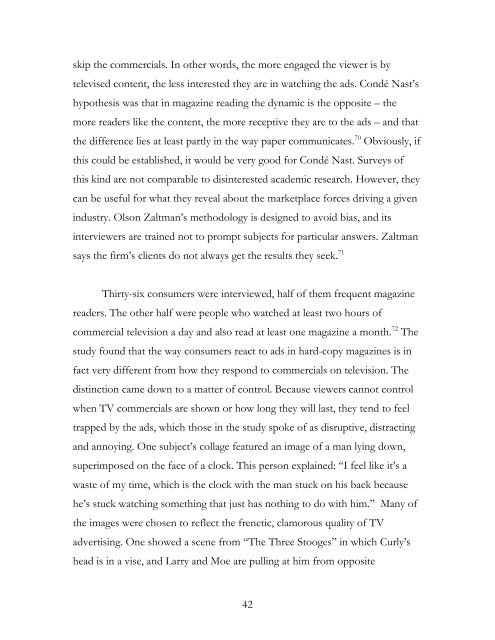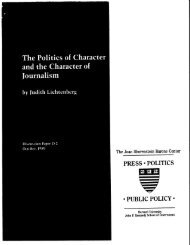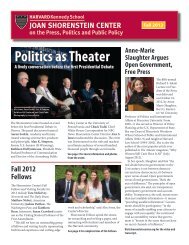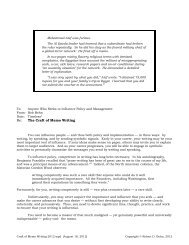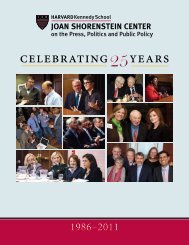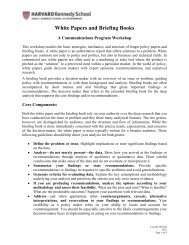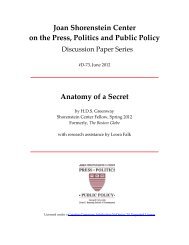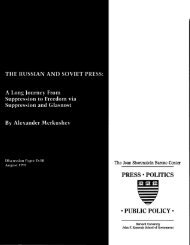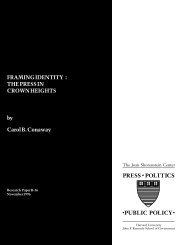Why Paper Is Eternal - Joan Shorenstein Center on the Press ...
Why Paper Is Eternal - Joan Shorenstein Center on the Press ...
Why Paper Is Eternal - Joan Shorenstein Center on the Press ...
Create successful ePaper yourself
Turn your PDF publications into a flip-book with our unique Google optimized e-Paper software.
skip <strong>the</strong> commercials. In o<strong>the</strong>r words, <strong>the</strong> more engaged <strong>the</strong> viewer is by<br />
televised c<strong>on</strong>tent, <strong>the</strong> less interested <strong>the</strong>y are in watching <strong>the</strong> ads. C<strong>on</strong>dé Nast’s<br />
hypo<strong>the</strong>sis was that in magazine reading <strong>the</strong> dynamic is <strong>the</strong> opposite – <strong>the</strong><br />
more readers like <strong>the</strong> c<strong>on</strong>tent, <strong>the</strong> more receptive <strong>the</strong>y are to <strong>the</strong> ads – and that<br />
<strong>the</strong> difference lies at least partly in <strong>the</strong> way paper communicates. 70 Obviously, if<br />
this could be established, it would be very good for C<strong>on</strong>dé Nast. Surveys of<br />
this kind are not comparable to disinterested academic research. However, <strong>the</strong>y<br />
can be useful for what <strong>the</strong>y reveal about <strong>the</strong> marketplace forces driving a given<br />
industry. Ols<strong>on</strong> Zaltman’s methodology is designed to avoid bias, and its<br />
interviewers are trained not to prompt subjects for particular answers. Zaltman<br />
says <strong>the</strong> firm’s clients do not always get <strong>the</strong> results <strong>the</strong>y seek. 71<br />
Thirty-six c<strong>on</strong>sumers were interviewed, half of <strong>the</strong>m frequent magazine<br />
readers. The o<strong>the</strong>r half were people who watched at least two hours of<br />
commercial televisi<strong>on</strong> a day and also read at least <strong>on</strong>e magazine a m<strong>on</strong>th. 72 The<br />
study found that <strong>the</strong> way c<strong>on</strong>sumers react to ads in hard-copy magazines is in<br />
fact very different from how <strong>the</strong>y resp<strong>on</strong>d to commercials <strong>on</strong> televisi<strong>on</strong>. The<br />
distincti<strong>on</strong> came down to a matter of c<strong>on</strong>trol. Because viewers cannot c<strong>on</strong>trol<br />
when TV commercials are shown or how l<strong>on</strong>g <strong>the</strong>y will last, <strong>the</strong>y tend to feel<br />
trapped by <strong>the</strong> ads, which those in <strong>the</strong> study spoke of as disruptive, distracting<br />
and annoying. One subject’s collage featured an image of a man lying down,<br />
superimposed <strong>on</strong> <strong>the</strong> face of a clock. This pers<strong>on</strong> explained: “I feel like it’s a<br />
waste of my time, which is <strong>the</strong> clock with <strong>the</strong> man stuck <strong>on</strong> his back because<br />
he’s stuck watching something that just has nothing to do with him.” Many of<br />
<strong>the</strong> images were chosen to reflect <strong>the</strong> frenetic, clamorous quality of TV<br />
advertising. One showed a scene from “The Three Stooges” in which Curly’s<br />
head is in a vise, and Larry and Moe are pulling at him from opposite<br />
42


